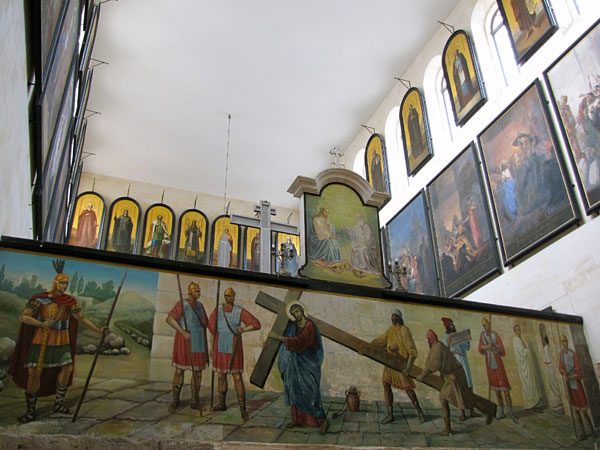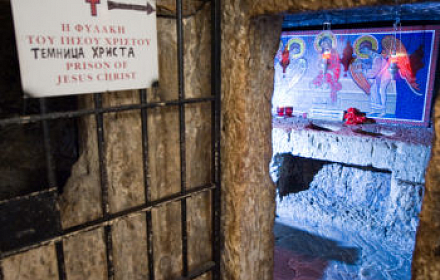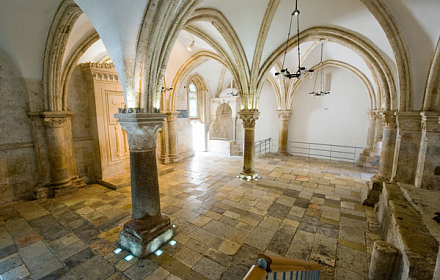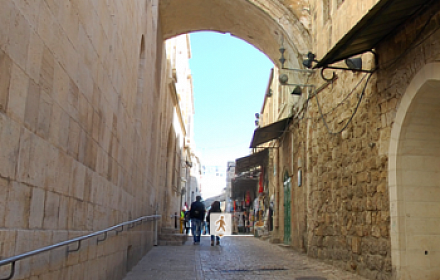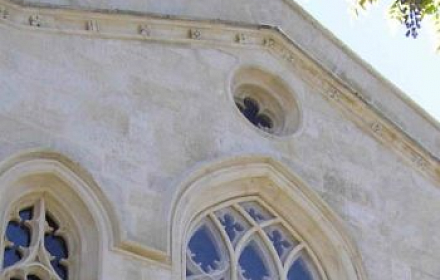About Virtual Tour
Among the Russian holdings in the Holy City there is one located next to the Church of the Holy Sepulcher – in just some seventy meters. The compound is called “The Alexander Nevsky Compound” or “The Russian House” — this is where thousands of Orthodox pilgrims from Russia and ex-USSR countries begin their journey across the Christian religious shrines in Jerusalem and in the Holy Land. Let's go on a virtual pilgrimage.
Both the compound and the church were named after the Faithful Saint Prince Alexander Nevsky — one of the most brilliant and yet controversial figures in Russian history. At various times in his life he bore such titles as the prince of Novgorod, grand prince of Kiev, prince of Pereslavl-Zalessky, and grand prince of Vladimir. In 1225, at the age of 4, Alexander went through the rite of passage to military life at the wish of his father, grand prince Yaroslav Vsevolodovich. He has been widely regarded as the national hero and was subsequently canonized as a saint thanks to his military victories and defense of Orthodox faith across the Russian lands. To this day, the Order of St. Alexander Nevsky remains one of the highest decorations in Russian Federation. In 2008 he was declared the main hero of Russia’s history by popular vote held within the framework of “The Name of Russia” TV project, leaving far behind such notable personalities as the poet Alexander Pushkin and cosmonaut Yuri Gagarin. But all this will be much later, after some centuries. In his lifetime the grand prince was known for his military leadership and resistance to Swedish expansion into the Russian lands and for several victories over the Teutonic Knights. Historians believe that it was Alexander who reversed the Kievan Rus’ orientation from the West to the East, preferring a vassal state subordination to latitudinarian Golden Horde to a union with Roman Catholic Church who wanted to convert the land to Catholicism. Historians have different points of view regarding the prince’s relations with Mongols, but one thing is certain: the sanctity of Alexander Nevsky for Russian Orthodox Christians is clear and indisputable – his role in Russian history can only be comparable to no more than two or three other historical personalities.
This is the reason why in 1896 the church of the Russian compound in Jerusalem was consecrated in honor of the Faithful Saint Prince Alexander Nevsky — patron saint of the Russian emperor Alexander III, who participated actively in its construction, though did not live till the moment when two years later the first service took place. But we are getting ahead of ourselves. Let’s go inside and continue our visit.
Archway
In 1856 the plot of land on which the compound stands was sold by Ethiopian church to Russian senator Boris Mansurov — a member of the Board of Trustees of the Imperial Orthodox Palestine Society. It was originally intended to build here a consulate, but the archaeological excavations financed by Sergey Alexandrovich Romanov (who visited Jerusalem as pilgrim), led to reconsider the land’s designation purpose. During the excavations led by the leading archaeologists of the world — Eugène-Melchior vicomte de Vogüé, Conrad Schick, Charles Wilson — a fragment of the ancient Jerusalem city wall dating back to King Herod the Great period was discovered. We are talking about a threshold that belonged to the Judgment Gate, and an archway of Emperor Hadrian time. Among the most significant discoveries were the remains of Emperor Constantine’s 4th century basilica – with its columns, kerfs, and a spacious room with thick walls of the same period. Divergent views have been expressed by historians and archaeologists concerning the stairway. Some consider it to be part of a magnificent Byzantine basilica built during the reign of Constantine the Great. Others attribute the arch to Roman times, when emperor Hadrian rebuilt the city of Jerusalem that was left in ruins by emperor Titus Flavius, and maintain that the archway was part of Hadrian’s capitol – one of the spans of the big arch that led into the Temple of Jupiter. In fact there is no apparent contradiction between these two versions: the discovered archway might be built by Hadrian, but later re-used in the basilica. One way or another, but this plot of land was selected for a new church. Since its direct proximity to the Church of the Holy Sepulcher could raise objections from the Ottoman authorities, it was decided to proceed with construction works in secrecy. For example, women transported church bells from Jaffa to Jerusalem on carriages in the middle of the night – you can see them today inside the small adjacent bell tower, beside the two ancient granite columns… From the outside the building reminded a typical house in the faraway Saint Petersburg, but its interior was particularly characteristic for a church. George Franghias (already known for St. Sergius Compound in the western part of Jerusalem and the Church of Mary Magdalene near the Garden of Gethsemane) was invited as the project’s architect. Orthodox Greek Nikolas Valsamaki became the construction contractor. While the Imperial Orthodox Palestine Society was engaged into construction, Russian diplomats were making efforts to coordinate the plan with Turkish authorities. Finally in 1887 a firman was granted, followed by the foundation stone laying ceremony. However the event was purely formal, as in fact the construction works on the site known as “Russian Excavations” were already underway. The church building with a floor area of 1342 square meters but without any conveniences was consecrated in 1891 by Archimandrite Antonin (Kapustin) – head of the Russian Orthodox Ecclesiastical Mission in Jerusalem in presence of Nikolai Mikhailov – authorized representative of the Imperial Orthodox Palestine Society and the organization’s entire staff. And finally, five years later, on May 22, 1896, Greek Orthodox Patriarch of Jerusalem Gerasiumus I performed the rite of great consecration of the completed Church of St. Alexander Nevsky. Interestingly, the event was held in presence of Russian and Greek consuls, as well as the secretary of Turkish governor Beshar-Efendi. The adjacent museum’s collection features several objects related to its construction and consecration, and some much more ancient exhibits: precious chains, ancient chandeliers, coins, and many more.Judgement Gate
The history of Alexander Nevsky compound is inextricably linked to Russia: all dramatic events of the 20th century in the country’s history affected the life of this small island located in the Holy Land’s heart. With the outbreak of World War I, the compound was plundered by Ottoman subjects, as the Empire was in the state of war with Russia. During “godless decades” that followed, the flame of life was barely flickering, supported only with meager contributions… Only in the 21st century the place got its second wind. Significant renovations and repair work were undertaken, and a new cross was placed upon the roof. In the early summer of 2006 the compound and the Church of Faithful Saint Prince Alexander Nevsky were newly consecrated in presence of the leading Orthodox clerics. Let’s go back at a time when it all began. Its main inspirer, Archimandrite Antonin (Kapustin) envisaged the Church of Saint Alexander Nevsky to become the centerpiece of the “Russian House”, while the Judgment Gate’s Threshold – by which Jesus left the city of Jerusalem on the way to the hill of Calvary – to become the central part of the church itself. It was called “The Judgment Gate” because on its threshold Roman officials read out the final sentences and hung them on the neck of the convicted. The person sentenced to death was escorted to the place of execution only surrounded by executioners and guards. This is how it happened in the case of Jesus. Until recently Ilya Repin’s icon “Carrying the Cross”, dedicated to this dramatic episode, hung on the church wall. The remains of the Judgment Gate’s Threshold with an adjacent fragment of the ancient pavement are under a glass covering and protected on three sides with openwork metallic grates. A wooden cypress cross made at the Orthodox Monastery of St. Panteleimon on Holy Mount Athos, Greece stands upon the stone brought from near Jerusalem. The cross seems to indicate to every person entering the church the way to its main sanctuary. Seven vigil lights are hanging above the Threshold, two of which — the Tsar’s and the Palestine Society’s are eternal lamps. The plates feature the names of those who made donations: cloisters, episcopates and fellowships from America, Europe and Russia. Other artworks inside the Church were made by the Russian artist Nikolai Koshelev: eighteen large canvases are dedicated to the Passion of the Christ. Each of these paintings measures two by three meters – the series starts with “Agony in the Garden of Gethsemane” and ends with the magnificent “Harrowing of Hell”… Interestingly, other prominent artists from Russia, such as Viktor Vasnetsov, Mikhail Nesterov and Nikolai Ge were unable to find a solution for such a large-scale task. The challenge was accepted only by Nikolai Koshelev, who in his 50s already had experience of working on the interiors of the Cathedral of Christ the Savior in Moscow and the Church of the Savior on Blood in Saint Petersburg. He decided to present the set of paintings depicting the Passion of Christ sequentially and almost directly to one another. At the same time he used the means of expression known in Byzantine art – when a considerable distance from the artwork to the viewer helps to avoid distortions. This is why the set of Passion of Christ paintings hangs so high. Raising one’s eyes, in his mind the viewer ascends to each of the scenes depicted on these magnificent canvases – be it the scene where the Master gets arrested in the Kidron Valley, His interrogation by Pontius Pilate or the women myrrh-bearers meeting an angel near the empty tomb of Jesus. Placing his icons right below the row of windows, Koshelev combined the architectural interior with the scenes of Passions into a single ensemble. On the right from the Judgment Gate’s Threshold there is another icon on the wall, which depicts the Venerable Sergius of Radonezh in a beautiful icon-case made of pink marble with white and gray streaks. The kiot with the icon and the eternal lamp that stands in front of it were manufactured by Russian artisans and placed inside the Church at the request of the Grand Duchess Yelizaveta Fyodorovna after her husband was assassinated by revolutionary Ivan Kalyayev. The inscription above the icon says: “In memory of His Imperial Highness, the Grand Duke Sergey Alexandrovich – founder and chairman of the Imperial Orthodox Palestine Society. 1882–1905”. The vigil light in front of the kiot was lit in Moscow – the place of Grand Duke’s death, and brought by his wife to Jerusalem. Since then and to this day it has been called “The Elisabethan” eternal vigil lamp. Grand Duchess Yelizaveta Fyodorovna, born Princess Elisabeth of Hesse-Darmstadt, collected her husband’s body blown to pieces by the bomb. Later she was able to find the strength to meet the Grand Duke’s assassin, spoke to him, forgave him and even begged the Russian sovereign to give him his life… She continued the lifelong work of her husband in Jerusalem, until she was martyred by Bolsheviks in 1918 – she was thrown into an abandoned iron mine’s shaft along with other members of the royal family. The Grand Duchess’ remains were taken abroad by White Russian émigrés and by her will were finally laid to rest in the Holy Land. In 1992 the Grand Duchess was canonized as Holy Martyr Elizabeth Feodorovna. When viewing the interior of the Church of St. Alexander Nevsky, we cannot walk past the altar stone in its center. Scientists believe it to be the fragment of a pillar that belonged to the original Byzantine basilica, which was called the Church of the Resurrection or Church of Anastasis, built in the 4th century A.D. by the Roman emperor Constantine the Great. The altar is covered with red velvet; today it’s used for prayer services and religious ceremonies. Among other landmarks are two dozens of black memorial plaques located near the Judgment Gate’s threshold. Each of them features the name of a benefactor and the date of his death, inscribed with golden letters. Some of the names are widely known – among them is the aforementioned Archimandrite Antonin (Kapustin) – head of the Russian Orthodox Ecclesiastical Mission in Jerusalem, a specialist in Biblical archaeology and ancient manuscripts, who died in 1894 – two years before the great consecration of the completed Church of Saint Alexander Nevsky and the compound. Among other prominent people inscribed are the Russian emperor Alexander III and Russian 19th century statesman Konstantin Petrovich Pobedonostsev.Church
Let’s continue our tour across the Church of St. Alexander Nevsky – or it would be more correct to say – through its liturgical hall, as the building houses not only this church, but also a few other premises. Beside the aforementioned bell tower and museum, there is a presence-chamber, which is called “Tsar’s chamber” – although none of Russian tsars had ever been here. There are also a library, an archive, rooms for clergy and employees, and general wards for pilgrims. The windows of the lower ground floor, ground floor and the first floor overlook a square shady courtyard in the middle of the compound. We are not going to visit these places today, and will return inside the church instead. It’s fairly spacious with a height of 10 meters and a length of 22 meters. That’s a lot, especially considering that the total area of the Alexander Nevsky compound in Jerusalem is 1433 square meters. Iconostasis – the place that all faithful turn to during divine services – is the central part of every Orthodox Church. In this case it’s a double-row, gorgeously carved templon of Byzantine type. There are thirty icons upon the iconostasis. Among them are the icons of Christ of Edessa, Virgin Mary, Russian hierarchs Iona, Peter and Alexei, icons of Stephen the Protomartyr, Archangel Gabriel and some others featuring the great feasts of the Orthodox Church. The Holy Doors depict a scene of the Annunciation and faces of the four gospel evangelists. An icon of the Last Supper is directly above the Doors. Behind the iconostasis is the altar, whose triple-gazed window is decorated with stained glass in Russian Art Nouveau style. It depicts the Crucifixion with Virgin Mary and St. John the Evangelist who stand before the Holy One. Such creative solution is not to be seen frequently in an Orthodox church – but in this case the stained glass works look natural. Now let us take a step back and turn to the opposite from the altar side. Here, the western wall of the church presents some kind of iconographic gallery, which consists of fourteen icons in black frames of the same size. All these depictions were made by a brilliant master – painter Paskhin from Saint Petersburg. The full-length figures of saints from different periods and countries are full of inner peace and spiritual greatness. Russian pilgrims immediately recognize among them Basil the Great and Alexander Nevsky, Mary Magdalene and Mary the Egyptian, Saint Grand Princess Olga Equal to the Apostles and the Venerable Sergius of Radonezh… The remaining northern and southern walls are belted by series of three-meter icons, hanging between the windows and having the same height. These icons depict, among other saints, John the Baptist Christ’s forerunner, St. George the Great Martyr and Bringer of Victory, John of Damascus, Sabbas the Sanctified, and last but not least Equal to the Apostles Saint Constantine the Great and his mother Saint Helena of Constantinople. In fact, the Alexander Nevsky Compound stemmed from the Imperial Orthodox Palestine Society, whose activity never ceased even in “godless years”. During the Soviet era this organization was named “Russian Palestine Society” and was part of the Academy of Sciences. In 1992, the starting point of Russia’s recent history, the society was given back its historic name. In 2005 the organization obtained legal registration in the state of Israel and resumed its activity in the Holy Land as a non-commercial society. Although the compound building’s neo-baroque style makes it possible to define quite precisely the period of its construction — late 19th century — our time has added something new: in the new millennium a chapel dedicated to Our Lady of Saint Theodore was built (consecrated in 2008). During the same years, in 2007 and in 2008 the Alexander Nevsky Compound became the venue for St. Sergius and St. Elizabeth Readings – an important cultural and spiritual event for Russian Orthodoxy in the Holy Land. This way, the current activity of Alexander Nevsky Compound’s staff gives meaning to the historical motto of the Imperial Orthodox Palestine Society – a verse from Isaiah: “For Zion’s sake will I not hold my peace, for Jerusalem’s sake I will not rest”. Indeed, for this is the place from where the voice of the thousand-year-old Russian Orthodoxy makes its way across the Holy Land and far beyond. …The exit from the Church of St. Alexander Nevsky is located near the Judgment Gate’s Threshold and leads to Russian Street.Send donation
If you are in a difficult financial situation, we will light the candle for free. For that purpose email us at coordinator@santosepulcro.co.il
Payment Methods
